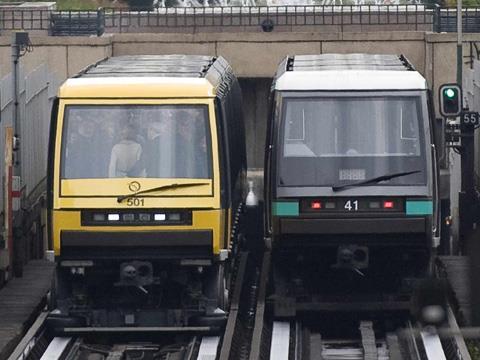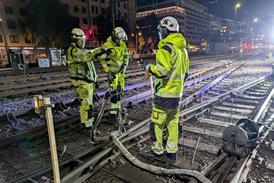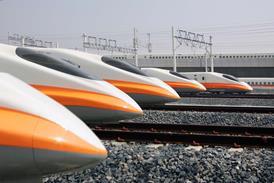
Driverless metros, which are becoming increasingly common around the world, generally have low operational labour costs as well as high passenger capacity. But automation also has a lesser-known advantage: speed. Not only can computer-controlled trains drive more closely together, but they are also faster. The difference appears to be substantial, perhaps as much as 20 sec per station.
The biggest determinant of average metro speed is the station spacing, with those further apart allowing higher average speeds. However, driverless lines are fast even taking this into account. London Underground stations have a mean distance of about 1·25 km between them, and trains reach an average speed of 33 km/h. The Tokyo metro has the same inter-station distance and an average speed of around 30 km/h. In contrast, the driverless København metro has a scheduled average speed of about 35 km/h, with only 1 km between stations. Vancouver’s SkyTrain is also fast for its station spacing: the Expo Line averages 45 km/h with 1·5 km between stations, while the Canada Line averages 35 km/h with 1 km.
It is not just metros built as driverless that are fast. Paris metro Line 1 opened in 1900. With a minimum curve radius of 40 m and an average of 700 m between stations, it could never achieve a high average speed. Following the line’s automation, carried out in 2007-12, the average speed rose from 24·4 km/h to 30 km/h. Dwell times are rigidly set at 30 sec, and the timetabled average speed of 29 km/h is close to the theoretical maximum that can be achieved with the station spacing, based on current rolling stock acceleration rates.
Tireless computing
Much of the difference between manually operated and automatic trains comes down to suboptimal driver behaviour. Human train operators and computers both have to brake early enough to avoid overshooting the platform, but computers can use smaller safety margins, taking into account only variation in train and track characteristics. Human train operators often begin to brake earlier than a computer would, with their decision based on visual cues such as familiar landmarks above ground, or support columns or wayside signals underground.
Fatigue also affects driver performance, and research on this has been carried out in the main line sector. A study into high-speed rail in Sweden’s Gröna Tåget research programme found that factors including driver performance can affect travel speed by up to 7%, as drivers do not always apply the brakes at the right time for optimising speed or energy consumption. An article in the Journal of Sleep Research reported that between Melbourne and Adelaide, fatigued train drivers consume 9% more diesel than alert ones. An article in Railway Gazette International earlier this year discussed the effects of fatigue on the safety of commuter railways in North America.
The effect of driver behaviour is magnified on metros, where trains have many more acceleration and deceleration cycles on a given route, and often have to slow down because of congestion. Thus the difference can be substantially more than 7%, as the automation of Paris Line 1 shows.
Another example can be found in New York. One planner at New York City Transit explained to Metro Report that every train on the subway is designed with a maximum deceleration rate of 1·3 m/s2. In practice trains do not hit this maximum — they decelerate at roughly two-thirds of this rate. The planner explained that NYCT reprimands drivers who exceed the maximum speed and trip the ATP system, but drivers who stay under the speed limit are not punished. The incentive is for drivers to err on the side of slower rather than faster speeds. Thus they begin braking earlier; they also slow down for red signals even if these will change to green were they to keep going.
Partial improvements to speed can be made without full automation. Some of the largest metro networks in the world have installed communications-based train control on some lines in order to add more capacity — adding a degree of automation without making the lines fully driverless.
So far the only metro line in New York with CBTC is the L-Canarsie Line, which saw no immediate speed increase as a result of the signalling upgrade. However, its timetables have held up better than those on other lines, where they have been made more fragile in recent years by speed restrictions and a workplace culture that puts less emphasis on speed.
Living on the edge
Another reason why ATO helps trains to perform better is that stations on automated metro lines often have platform edge doors. These necessitate precise stopping so that the train doors align with the PEDs. Such precision can only be achieved with modern signalling, typically CBTC. PEDs were fitted to stations on Paris metro Line 13 at the same time as CBTC was installed. RATP also installed PEDs on Line 1 when it was automated, and the operator is doing the same as it automates Line 4. At 26 km/h, Line 13 is slightly faster than the network average (it has an mean station spacing of 720 m), although it is still slower than Line 1.
A further reason why PEDs improve train speed is that they allow trains to enter stations at full speed. Without barriers between the platform and the track, passengers may lean over the platform edge to peer down the tunnel, forcing the train to slow down more sharply as it enters the station.
Driverless trains serving stations with PEDs save about 20 sec per station stop. Judging by the relative speeds of Vancouver SkyTrain and Paris Line 13, the bulk of the speed gain comes from automation rather than from PEDs. This saving compares favourably with average delays on the largest metro networks. The average delay is about 4 min in London and 3 min in New York. With variations in average journey lengths in those cities, the time saving achieved through using driverless trains is equivalent to eliminating about half of the delays in London or all delays in New York.
Ultimately, computers are more precise and accurate than humans at narrow technical tasks, such as driving a train. The greater precision of ATO and CBTC have led some operators to adopt these technologies to increase capacity by running trains at shorter headways, but automation also permits substantial increases in speed.







